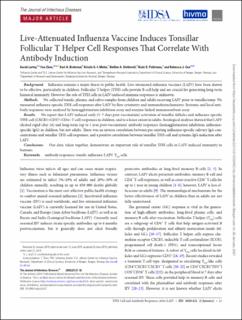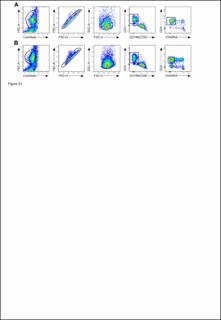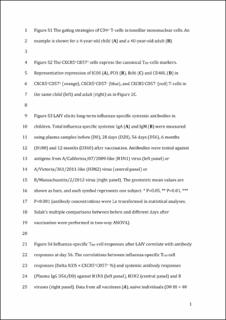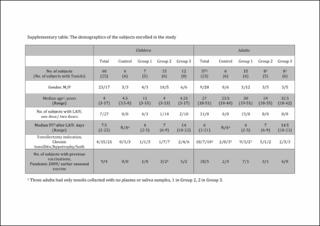| dc.contributor.author | Jalloh, Sarah Larteley Lartey | |
| dc.contributor.author | Zhou, Fan | |
| dc.contributor.author | Brokstad, Karl Albert | |
| dc.contributor.author | Mohn, Kristin Greve-Isdahl | |
| dc.contributor.author | Slettevoll, Steffen Aleksander | |
| dc.contributor.author | Pathirana, Rishi | |
| dc.contributor.author | Cox, Rebecca Jane | |
| dc.date.accessioned | 2021-06-22T12:17:13Z | |
| dc.date.available | 2021-06-22T12:17:13Z | |
| dc.date.created | 2020-06-06T13:18:11Z | |
| dc.date.issued | 2020 | |
| dc.Published | Journal of Infectious Diseases. 2020, 221 21-32. | |
| dc.identifier.issn | 0022-1899 | |
| dc.identifier.uri | https://hdl.handle.net/11250/2760650 | |
| dc.description.abstract | Background: Influenza remains a major threat to public health. Live-attenuated influenza vaccines (LAIV) have been shown to be effective, particularly in children. Follicular T helper (TFH) cells provide B-cell help and are crucial for generating long-term humoral immunity. However the role of TFH cells in LAIV-induced immune responses is unknown.
Methods: We collected tonsils, plasma, and saliva samples from children and adults receiving LAIV prior to tonsillectomy. We measured influenza-specific TFH-cell responses after LAIV by flow cytometry and immunohistochemistry. Systemic and local antibody responses were analysed by hemagglutination inhibition assay and enzyme-linked immunosorbent assay.
Results: We report that LAIV induced early (3–7 days post-vaccination) activation of tonsillar follicles and influenza-specific TFH-cell (CXCR5+CD57+CD4+ T cell) responses in children, and to a lesser extent in adults. Serological analyses showed that LAIV elicited rapid (day 14) and long-term (up to 1 year post-vaccination) antibody responses (hemagglutination inhibition, influenza-specific IgG) in children, but not adults. There was an inverse correlation between pre-existing influenza-specific salivary IgA concentrations and tonsillar TFH-cell responses, and a positive correlation between tonsillar TFH-cell and systemic IgG induction after LAIV.
Conclusions: Our data, taken together, demonstrate an important role of tonsillar TFH cells in LAIV-induced immunity in humans. | en_US |
| dc.language.iso | eng | en_US |
| dc.publisher | Oxford University Press | en_US |
| dc.rights | Navngivelse 4.0 Internasjonal | * |
| dc.rights.uri | http://creativecommons.org/licenses/by/4.0/deed.no | * |
| dc.title | Live-attenuated influenza vaccine induces tonsillar follicular T helper cell responses that correlate with antibody induction | en_US |
| dc.type | Journal article | en_US |
| dc.type | Peer reviewed | en_US |
| dc.description.version | publishedVersion | en_US |
| dc.rights.holder | Copyright 2019 The Authors | en_US |
| cristin.ispublished | true | |
| cristin.fulltext | original | |
| cristin.qualitycode | 2 | |
| dc.identifier.doi | 10.1093/infdis/jiz321 | |
| dc.identifier.cristin | 1814179 | |
| dc.source.journal | Journal of Infectious Diseases | en_US |
| dc.source.40 | 221 | |
| dc.source.pagenumber | 21-32 | en_US |
| dc.relation.project | Norges forskningsråd: 271160 | en_US |
| dc.relation.project | Norges forskningsråd: 284930 | en_US |
| dc.relation.project | Norges forskningsråd: 815818 | en_US |
| dc.relation.project | Norges forskningsråd: 811752 | en_US |
| dc.identifier.citation | Journal of Infectious Diseases. 2020, 221(1), 21–32 | en_US |
| dc.source.volume | 221 | en_US |
| dc.source.issue | 1 | en_US |




